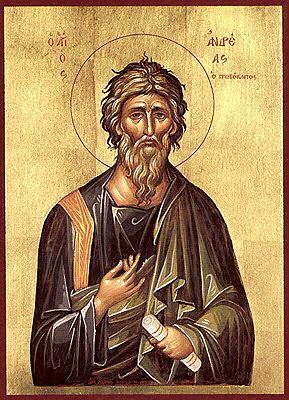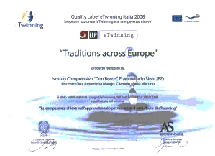
The 30th of November is one of the important Romanian holidays. It is the day we celebrate Saint Andrew (in Romanian his name is Andrei), the apostle who christianised our people and the protector of our country.
There are many traditions without religious meaning connected to this day, some of them having their origin on the Roman celebrations of Saturn. The Dacian New Year took place from the 14th of November until the 7th of December, this was the interval when time began its course.
Saint Andrew is seen as an old man, because now the Sun is old and tired too, it has no power. From the weather this day one can predict if the winter is going to be long and frosty.
One of the elements that came from the Roman and Thracian celebrations was the one about wolves. Is it only a coincidence that we, the descendants of Dacians, whose flag was shaped as a wolf, have chosen the patron of wolves as our protector? During this night, the wolves are allowed to eat all the animals they want. It is said that they can speak, too, but anyone that hears them will die soon.
Early on St. Andrew’s day, the mothers go into the garden and pick tree branches, especially from apple trees, pear trees, cherry trees, but also rose -bush branches. They make a bunch of branches for each family member. The one whose bunch will bloom by New Years day will be lucky and healthy next year.
On St. Andrew’s night ghosts haunt and harass the people. For protection, one should rub the entrance door with garlic and turn all the dishes upside down. A special party takes place now, called “Guarding the garlic”. Boys and girls gather in a house with the doors and windows rubbed with garlic . They also put garlic (three bulbs for each girl) in a wooden tub that is to be guarded till day-break by an old woman, in a candle-lit oom. They party all night and in the morning the wooden tub is taken outside and they dance around it. Then they all take some garlic home as protection against illness or spells.
St. Andrew is the patron of the wolves, being the one who protects the people attacked by these animals. St. Andrew is also celebrated in order that the wolves should stay away from the households or from the travelers. The salt is charmed and buried under the door of the stable. It will be taken out on St. George and given to the cattle, as a protection against the wolves and other evil things.
Nothing is lent on this day, so that the products of the field shouldn’t be stolen. The women aren’t allowed to wash or to comb their hair.
The children put apple, pear or plum branches in the water, so that they would bloom. These will be used on St. Vasile, as a “sorcova”. The girls and boys seed wheat and the one whose wheat grew more will be the luckiest one.
But the best known tradition connected to this night is the one about matrimony and premonitory dreams. Single girls must put under their pillow either a branch of sweet basil, or , better 41 wheat grains.If someone takes the grains in their dreams, that means the girl will marry soon. They can also plant wheat in a dish and water it until New Year’s day. The nicer the wheat looks that day, the better the year to come.
All these traditions have no religious meaning, but they are preserved in Romanian people’s hearts and they are followed year after year.
Irina and the kids from Shool no 92, Bucharest


 American President, Theodore Roosevelt does not want to shoot a bear cub while he is hunting. Teddy is a diminutive form of Theodore. To celebrate the event, 100 years later the 25th November became World Teddy Bear Day.
American President, Theodore Roosevelt does not want to shoot a bear cub while he is hunting. Teddy is a diminutive form of Theodore. To celebrate the event, 100 years later the 25th November became World Teddy Bear Day. Open to the world – keep memories
Open to the world – keep memories












Recent Comments